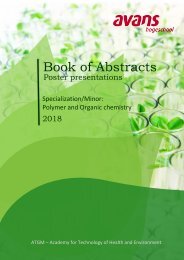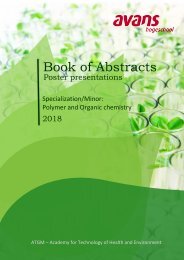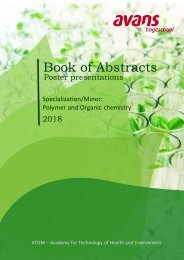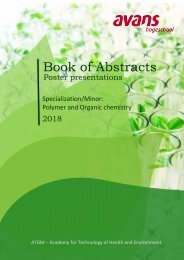Book of abstracts version 5
Create successful ePaper yourself
Turn your PDF publications into a flip-book with our unique Google optimized e-Paper software.
<strong>Book</strong> <strong>of</strong> <strong>abstracts</strong> SPOC 2018<br />
Synthesis and purification <strong>of</strong> bio-based monomers<br />
Author<br />
Keanu Manders<br />
Academy <strong>of</strong> Technology for Health and Environment<br />
Avans Hogeschool, Breda<br />
University <strong>of</strong> Maastricht<br />
purification <strong>of</strong> bio-based monomers<br />
Abstract<br />
The synthesis <strong>of</strong> bio-based polymers is a growing subject, not only due to their green qualities, but also because they have<br />
better physical characteristics compared to other plastics. With the combination <strong>of</strong> itaconic acid and a diamine,<br />
Maastricht University, formed a bio-degradable monomer (fig 1.) The possibility to apply variation in the chain length (n)<br />
<strong>of</strong> the diamine, gives the molecule the ability to form a monomer with great variation <strong>of</strong> chain lengths. The challenging<br />
part <strong>of</strong> this research is however the purification <strong>of</strong> the molecule. When the chain length is varied, the yield <strong>of</strong> the target<br />
molecule decreases. The objective <strong>of</strong> this research is finding the most efficient way to synthesize and purify the monomer.<br />
It is expected that when a more efficient method is determined a yield <strong>of</strong> 85% is possible for t he most difficult chain<br />
lengths [1]. However the presence <strong>of</strong> chiral centrums in the molecule could complicate the purification. To determine the<br />
purity <strong>of</strong> the molecule DSC will be used to compare the Tg (˚C), Tm (˚C) and Td (˚C) with previous found results. The<br />
molecule will be synthesized via a Michael addition. Three different diamines (1,4 -diaminobutane; ethylenediamine; 1,5-<br />
diaminopropane) are used as starting reactants. In the presence o f water, itaconic acid will react via the Michael addition<br />
to form the desired monomer [2]. The next step is then to purify the molecule via different methods such as<br />
recrystallization in 50%/50% methanol water; vapor diffusion recrystallization or column chromatography [3].<br />
When the purity is satisfactory a final analysis <strong>of</strong> the product will happen at Maastricht University via NMR.<br />
Keywords: Bio-based, Bio-degradable monomer, diamines, Michael addition, recrystallization, purification<br />
Table <strong>of</strong> content<br />
Figure 1: The different target molecules using multiple diamines (1= ethylenediamine (n=2); 2= 1,4 -diaminobutane (n=4);<br />
3=1,5-diaminopropane (n=5)).<br />
Figure 2: The reaction equation <strong>of</strong> the monomer (1) and the polymerization <strong>of</strong> the monomer (2); with n for chain length<br />
and m for the number <strong>of</strong> monomers.<br />
[1] Roy, M., Noordzij, G. J., van den Boomen, Y., Rastogi, S., & Wilsens, C. H. (2018). Renewable (Bis) pyrrolidone Based<br />
Monomers as Components for Thermally Curable and Enzymatically Depolymerizable 2 -Oxazoline Thermoset Resins. ACS<br />
Sustainable Chemistry & Engineering, 6(4), 5053-5066.<br />
[2] Ayadi, F., Mamzed, S., Portella, C., & Dole, P. (2013). Synthesis <strong>of</strong> bis (pyrrolidone-4-carboxylic acid)-based polyamides<br />
derived from renewable itaconic acid—application as a compatibilizer in biopolymer blends. Polymer journal, 45(7), 766.<br />
[3] "Growing quality crystals," MIT Departement <strong>of</strong> Chemistry X -ray diffraction Facility, [Online]. Available:<br />
http://web.mit.edu /x-ray/cystallize.html. [Accessed 07 02 2018].<br />
27









